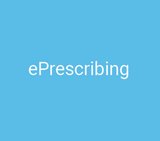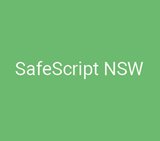ePrescribing & SafeScript NSW
ePrescribing
Under the National Health Plan for COVID-19, the Australian Government has accelerated the delivery of electronic prescribing to help protect people most at-risk in our community from exposure to COVID-19.
What you need to know about electronic prescribing
Electronic Prescribing (ePrescribing) provides an option for prescribers and their patients to have an electronic prescription (eScript) as an alternative to a paper-based prescription.
ePrescribing is the process by which a prescription is electronically generated by a prescriber using software which conforms to stringent specifications. Only an authorised prescriber can generate an electronic prescription, which is then securely transmitted to a prescription delivery service. The electronic prescription is then available for dispensing and supply through any dispensing software that conforms to the appropriate requirements.
Electronic prescribing is not mandatory, and patients and prescribers will be able to choose electronic or paper prescriptions.
The Australian Digital Health Agency (ADHA) has published information on electronic prescribing which explains how the process works and how to prepare your practice.
What are the benefits of electronic prescribing?
- Improved patient safety by reducing the risk of transcription errors;
- Improved practitioner workflow efficiencies by reducing unnecessary paperwork;
- Choice of prescription format that suits patient preference;
- Potential for new or alternative digital health services and initiatives into the future;
- Reduced prescription misuse through increased data available for real-time monitoring; and
- Support the future of digital health innovation.
Interim arrangements for e-prescribing to support telehealth
Image-based prescribing arrangements implemented at the start of the COVID-19 pandemic ended 31 March 2022, except with hospitals. Image-based prescribing currently only applies to the supply of pharmaceutical benefits for patients treated in public and private hospitals.
Electronic prescribing should not be confused with image-based prescribing. Factsheets on interim arrangements for supply of medicines to support telehealth patients in the community setting are available for prescribers and pharmacists.
Resources
SafeScript NSW - Realtime Prescription Monitoring
SafeScript NSW is a real-time prescription monitoring (RTPM) system allowing prescribers and dispensers access to their patient's prescription history for certain high-risk monitored medicines. SafeScript supports prescribers in making safer clinical decisions and reduces the prevalence of unsafe use of monitored medicines.
All prescribers (medical practitioners, nurses and dentists) and pharmacists registered with AHPRA can access SafeScript NSW, after they have registered.
The SafeScript NSW website contains education and training, patient information, resources, and frequently asked questions about SafeScript NSW. To further support the use of SafeScript NSW, HealthPathways has developed two pathways to help practitioners navigate this initiative.
How to Register for SafeScript NSW
To access SafeScript NSW, prescribers and pharmacists must register via the registration portal, where each clinician will be given their own unique username. For a quick guide on how to register, watch the short demonstration video below.
Accessing and Using SafeScript NSW
Prescribers or pharmacists can access SafeScript NSW either via the SafeScript NSW portal or integrated clinical software.
For clinical software access using Best Practice or Medical Director, download the latest version of your software on each computer used for prescribing, and then enable SafeScript by completing the following steps:
1. From the Main screen of BP Premier select Setup > Preferences > Prescribing tab
2. Tick the Enable real-time prescription monitoring checkbox
3. Click Save & Close
1. From the Clinical front screen, select User > Setup Users and open
2. Tick the Participate in SafeScript check box
SafeScript NSW Approval Management Functionality
From Monday, 13 November 2023, a new functionality has been made available allowing prescribers to manage their applications to prescribe or supply certain high-risk medicines online where required under the Poisons and Therapeutic Goods Act 1966.
Prescribers can submit applications for approval to prescribe or supply medicines under the NSW Opioid Treatment Program (OTP) and psychostimulants (dexamfetamine, lisdexamfetamine and methylphenidate). Applications for approval for other medicines will be added over the coming months.
This new functionality offers an efficient and centralised way for prescribers to efficiently submit their applications online and monitor application progress. Prescribers will receive responses to their applications faster.
To get started, view the Prescriber’s Guide on how to set up your SafeScript NSW account to apply for approvals. For further information, visit the new approval management functionality section on the SafeScript NSW website.
Improving SafeScript NSW data quality
Healthcare providers have a role in providing accurate data in our clinical systems to ensure SafeScript NSW have a single patient record with reliable information on the prescribers, pharmacists and medicines used.
Below are recommendations on how to improve accuracy of patient information stored on SafeScript NSW, which will ensure patient records are correctly matched, providing a more accurate patient history and reducing duplicate records in the system:
Record the patient’s date of birth in your clinical software
Ensure that that the patient’s date of birth is entered into your clinical system. Patient's DOB will improve patient safety by strengthening identification of the patient to ensure accurate information is stored in SafeScript NSW, avoiding duplication of patient records.
Validate the patient’s Individual Healthcare Identifier (IHI) in your clinical software
This will ensure that the right information is associated to the right individual at the point of care. Incorrect or missing IHIs can result in the creation of duplicate patient profiles in SafeScript NSW, which can lead to potentially inaccurate diagnosis, inappropriate prescribing and medical errors.
How do I validate a patient’s IHI?
Click the ‘Validate’ button within the IHI section of your patient’s record. The minimum information required is their surname, first name, date of birth, gender and Medicare/Department of Veterans’ Affairs card number.
Where can I find further instruction on how to validate IHI?
Click on any of the following clinical software links to get specific instructions on how you can validate this information on your system:
Ensure your practice and prescribing details are up to date in your clinical software
Having accurate contact information makes it easier for you to be contacted by other healthcare providers to clarify and confirm the treatment approach when required.
Ensure medicine information is entered correctly
When prescribing, avoid the free text entries where possible and record dosage and quantity information accurately. The SafeScript NSW alerts and notifications rely on this information being correct for it to accurately alert and notify prescribers and dispensers about any at-risk patients.
Education, Training and Clinical Support










